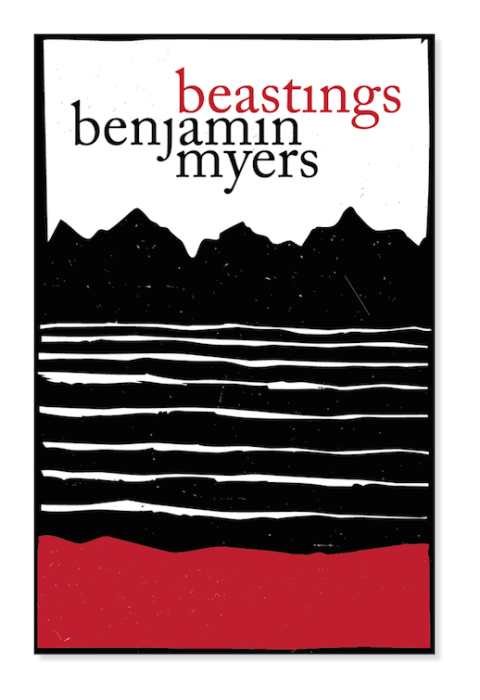
Review by Rob St. John
Beastings is a word that evokes an uneasy mix of newborn fragility and primitive savagery. Often spelt as ‘beestings’ or ‘biestings’ it is used to describe the first, watery milk produced by an animal after giving birth. In British military parlance, beastings describe the rough treatment of new recruits: a ‘breaking in’ rite of passage. And in many ways it provides an appropriate title for Benjamin Myers new book, a bleak, compelling novel about religion, fertility and ferality, played out amongst the Lake District fells where the line between (wo)man and beast often seems fragile and thin.
Myers’s previous novel, Pig Iron, told of a young man of traveller lineage attempting to shake the shackles of his past: a North Yorks noir that pitched up somewhere between Ross Raisin’s God’s Own Country and Geoffrey Household’s Rogue Male. Whilst Pig Iron was rightly lauded, receiving the inaugural Gordon Burns prize in 2013, there’s a clear sense of progression in Beastings, a new lyrical ambition and confidence that plots this tempestuous traverse of the North Country hills.
In many ways, it is impossible to mark Beastings at a defined point in time. A young women flees a convent workhouse in an unnamed Lakeland town carrying a child that is not her own. A priest, perhaps uncommonly concerned in her whereabouts, takes matters into his own hands and recruits a local poacher to track the women across the fells. The opening chapters have a claustrophobic and disorientating feel to them, an atmosphere of 17th century witch trials perhaps, where undertones of persecution and violence permeate every pore of the bedrock.
In fact, it isn’t until the women meets two ramblers that the historical setting of the novel is suggested. The campers’ early Primus stove (invented in 1892) seems so incongruous with the fire and brimstone pursuit up to that point that it has a briefly disorientating effect. Myers pieces together a picture of the Lakeland fells at the turn of the 20th century as a place where the distant past and modern age rub up against each other: a staging post in history where the slow turn of deep time in the hills is quickened by the growth of surrounding towns and their increasingly sprawling inhabitants.
And the cast of characters we meet are all central actors in this remaking of the landscape: the romantic wanderer; the ramblers plotting early courses across the hills; the Youth Hostel manager dealing with unsavoury travellers; a hermit, a hunter and a farmer; and of course, the priest, whose fervent pursuit of the women lends a Biblical air to the mountains. Whether spiritual, supernatural or something else entirely, the atmosphere of the fells here is consistently fierce.
A blurring of the prehistoric and the present seeps into much of Myers’s writing, and the mountains are frequently described as having some awestruck agency or sublime resonance of their own. As the women sets out on her escape towards an eventual savage freedom, she sees the fells for the first time: “They were hazy shapes that appeared to be shifting – those great broad backs of creatures whose heads were hidden in the earth and whose pointed tails snaked away to form unseen valleys. Future destroyers of civilisation.”
In another uncannily modern, but undoubtedly timeless scene, a pharmacist pushes the priest a sample of uppers labelled ‘Forced March’, which ignite his crazed drive to pursue the women. The pharmacist says to come back for more in a couple of weeks: perhaps inevitably the priest is back within days. The poacher, growing weary of the priest’s insatiable (and, as we gradually learn, corrupt and guilty) drive to find the women, winds him up by bringing up Darwin, evolution and the ‘death of God’ – topics that still seem prescient more than a hundred years later.
Altered states recur later when the increasingly desperate woman eats fistfuls of mushrooms found in the fringes of a field, and the subsequent lysergic smear of space and time adds a new mute terror to the fells (as if she didn’t have enough to worry about) as all the while the baby lies helpless and hungry nearby. Yet the woman picks herself up and carries on, though starving and fraying at the edges.
Amongst the transcendental scaffolding of this story, it’s these moments of humanity and strength that shine. The women’s drive to care for the child leads her to attempt to breastfeed forced, surrogate beastings wrought from her threadbare body. Yet, for all the tragedy that befalls her, the woman remains committed and resolute. Indeed, I don’t know if I have encountered such a strong, engaging character in a book for some time: this is startling, sublime writing.
If it’s necessary, a reference point for the tone of Beastings might be Cormac McCarthy’s Southern Gothic novels (not least in a scene involving a stable of horses). In addition, the needled bickering of the priest and the poacher on their pursuit often reminded me of Boswell and Johnson on their 18th century grand tour around the Scottish Hebrides.
In Pig Iron, the protagonist returns to a ‘green cathedral’ of trees in the countryside outside Durham as sanctuary from his problems. In Beastings, there’s a similar reverential tone given to the brooding Lakeland fells, except here they offer nothing but tribulations for the women, a path towards the novel’s shocking conclusion. This is a work out of time, with a distinct, dark and often-savage voice of its own that deserves every plaudit that it will doubtless receive.
Beastings is published July 3rd by Bluemoose Books. Pick up a copy in our shop here